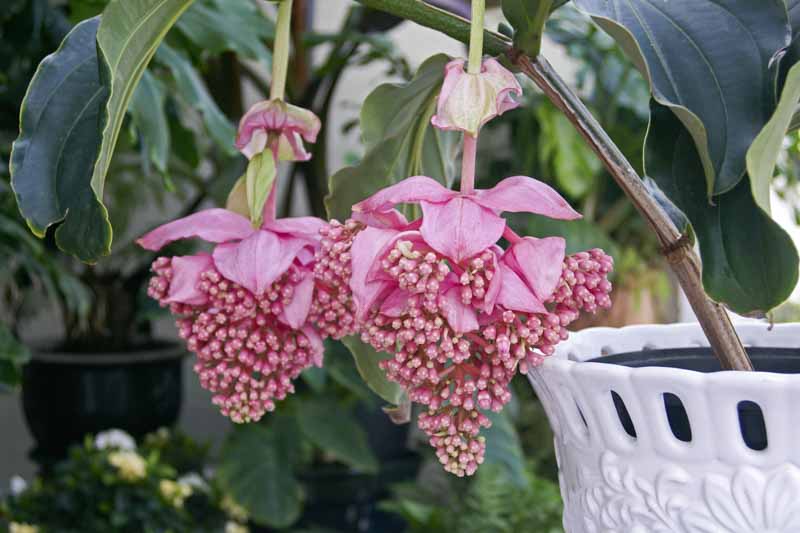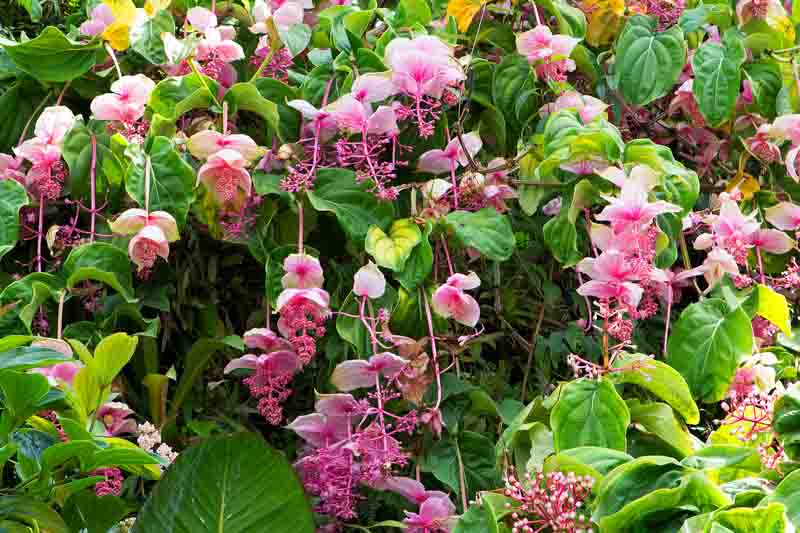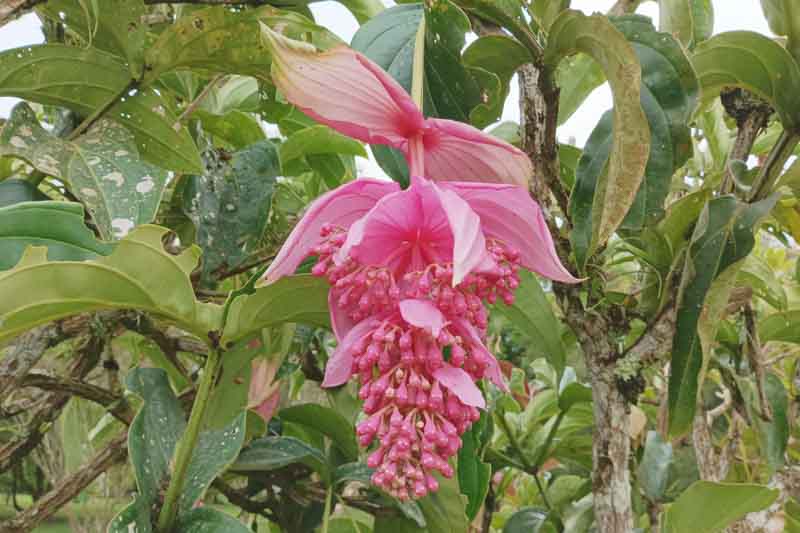Showy Medinilla, Magnificent Medinilla, Rose Grape
Medinilla magnifica, known as the “Showy Medinilla” or “Rose Grape,” is a stunning ornamental plant celebrated for its dramatic, cascading flower clusters and decorative foliage.
Medinilla magnifica is a magnificent addition to any plant collection, offering breathtaking floral displays and lush foliage that exemplify the beauty of tropical flora. It ranks as a top choice among tropical flowers.
Native: It originates from the Philippines, thriving in the tropical highlands, growing as an epiphyte on trees.
Plant Type and Habit: This epiphytic tropical evergreen shrub belongs to the Melastomataceae family, featuring a bushy, upright growth habit that tends to droop as its flower clusters mature.
Size: Medinilla reaches up to 10 feet (3 meters) tall in its native rainforest habitat, thriving in part shade from soil pockets on trees or the forest floor. It typically grows to a more compact size in containers, reaching 2-4 feet in height (60-120 cm) and 1-3 feet in spread (30-90 cm).
Flowers: The plant is famed for its pendulous, pink flower clusters, about 20 inches long (50 cm), each surrounded by prominent, pink bracts. The actual flowers are small, vibrant pink and appear in dense panicles. Flowering occurs mainly in the spring and summer, with the potential for additional blooms throughout the year in optimal conditions. After flowering, it produces non-edible, fleshy berries that turn from green to violet upon ripening.
Foliage: Its leathery leaves are large, 8-12 inches long (20-30 cm), ovate, and glossy dark green with prominent veins, adding to its ornamental value even when not in bloom.
Hardiness: Medinilla magnifica is hardy in USDA zones 10-11 and requires protection from temperatures below 50°F (10°C).
Uses: Primarily used as an ornamental plant, it’s ideal for indoor tropical displays, greenhouses, and sheltered patios or balconies in warm climates.
Toxicity: There is no significant toxicity reported for humans or pets, making it safe for indoor use around children and animals.
Invasiveness: Not known to be invasive; its cultivation is mostly controlled and confined to pots or specific garden spots.
Benefits: Beyond its ornamental appeal, it can enhance indoor air quality and add a vibrant, tropical feel to living spaces.

Growing and caring for Medinilla requires attention to its tropical origins to thrive.
Light: Prefers bright, indirect sunlight. Direct sun can scorch its leaves, while too little light may reduce blooming.
Soil: Well-draining, rich, and slightly acidic to neutral soil is ideal. Use a peat-based potting mix for best results.
Water: Keep the soil consistently moist but not waterlogged. Reduce watering in winter to prevent root rot.
Temperature and Humidity: Thrives in warm environments with temperatures between 65-75°F (18-24°C). High humidity levels, around 60% or higher, mimic its native tropical habitat. Avoid placing it in drafty areas or near heating and cooling vents to maintain consistent conditions.
Fertilization: Apply a balanced, liquid fertilizer every 4-6 weeks during the growing season. Cease fertilization in the dormant winter months.
Pruning: After flowering, prune back stems to encourage bushiness and remove any dead or damaged foliage to maintain plant health.
Repotting: Medinilla should be repotted every 2-3 years or when it becomes root-bound. Choose a pot slightly larger than the current one and use a fresh, well-draining potting mix. Repotting in spring encourages healthy growth and minimizes stress on the plant.
Propagation: Propagate by seed, softwood cuttings in spring or semi-ripe cuttings in summer
Select a Healthy Stem: Choose a healthy, non-flowering stem with at least two nodes (points on the stem where leaves attach).
Cut: Using a clean, sharp knife or scissors, cut a 4-6 inch segment (10-15 cm) of the stem.
Prepare the Cutting: Remove the leaves from the lower half of the cutting to prevent rotting when planted.
Rooting Hormone (Optional): Dip the cut end into rooting hormone powder to encourage root development.
Plant: Insert the cutting into a pot filled with a moist, well-draining potting mix. Ensure at least one node is buried beneath the soil surface.
Environment: Place the pot in a warm, brightly lit area but out of direct sunlight. Covering the pot with a plastic bag can help retain humidity, but ensure to ventilate occasionally to prevent mold growth.
Water: Keep the soil lightly moist but not waterlogged.
Rooting: Roots typically develop in 4-6 weeks. Check gently for resistance to confirm root growth.

Medinilla plants may encounter several pests, diseases, and common problems, especially when grown in less than ideal conditions.
Spider Mites: Indicated by fine webbing on the plant and tiny, moving dots (the mites), these pests thrive in dry conditions. Increase humidity and wash the plant with water or use miticides if necessary.
Mealybugs: These pests appear as small, white, cottony masses on leaves and stems, sucking sap and weakening the plant. Treat by dabbing with alcohol or applying insecticidal soap.
Scales: Hard or soft scales may attach to stems and leaves, also sucking sap. Remove manually or treat with horticultural oil.
Root rot: Caused by overwatering and poor drainage, symptoms include yellowing leaves and a wilting plant. Ensure proper drainage and let the soil dry out between waterings.
Powdery mildew: Appears as a white powdery substance on leaves in humid conditions. Improve air circulation and treat with fungicides designed for mildew control.
Leaf Drop: May occur due to sudden changes in temperature, light, or watering habits. Maintain consistent care and slowly acclimate the plant to changes.
Browning Leaf Tips: Often a sign of low humidity or over-fertilization. Increase humidity around the plant and ensure you’re not applying too much fertilizer.
Lack of Flowers: Insufficient light is a common cause. Place the plant in a location where it receives bright, indirect light to encourage blooming.

No, Medinilla is not an orchid. It belongs to the family Melastomataceae, which is distinct from the Orchidaceae family that orchids belong to. Medinilla is known for its stunning flowers and ornamental leaves, similar to some orchids, but it has different care requirements and growth habits.
Medinilla is a perennial plant in its native tropical environment or under similar conditions in greenhouses or indoors.
Medinilla berries are not commonly consumed, and there’s limited information on their edibility for humans. Generally, it’s best to err on the side of caution and not eat the berries of ornamental plants unless specifically stated as safe.
There is no specific listing of Medinilla being toxic to dogs in the ASPCA’s database of toxic and non-toxic plants. However, the absence of information on its toxicity does not guarantee it’s safe. It’s always prudent to prevent pets from ingesting plants not known to be non-toxic.
There’s limited information on the edibility of Medinilla flowers for humans. They are primarily grown as ornamental plants for their aesthetic value rather than for consumption. Unless a reliable source confirms their safety for culinary use, it’s best not to consume the flowers.
| Hardiness |
10 - 11 |
|---|---|
| Plant Type | Shrubs |
| Plant Family | Melastomataceae |
| Exposure | Partial Sun |
| Season of Interest |
Spring (Early, Mid, Late) Summer (Early, Mid, Late) Fall Winter |
| Height |
2' - 4' (60cm - 120cm) |
| Spread |
1' - 3' (30cm - 90cm) |
| Maintenance | Low |
| Water Needs | Average |
| Soil Type | Loam, Sand |
| Soil pH | Acid, Neutral |
| Soil Drainage | Moist but Well-Drained |
| Characteristics | Showy, Evergreen |
| Garden Uses | Beds And Borders, Patio And Containers |
| Hardiness |
10 - 11 |
|---|---|
| Plant Type | Shrubs |
| Plant Family | Melastomataceae |
| Exposure | Partial Sun |
| Season of Interest |
Spring (Early, Mid, Late) Summer (Early, Mid, Late) Fall Winter |
| Height |
2' - 4' (60cm - 120cm) |
| Spread |
1' - 3' (30cm - 90cm) |
| Maintenance | Low |
| Water Needs | Average |
| Soil Type | Loam, Sand |
| Soil pH | Acid, Neutral |
| Soil Drainage | Moist but Well-Drained |
| Characteristics | Showy, Evergreen |
| Garden Uses | Beds And Borders, Patio And Containers |
How many Medinilla magnifica (Rose Grape) do I need for my garden?
| Plant | Quantity | |
|---|---|---|
| Medinilla magnifica (Rose Grape) | N/A | Buy Plants |
Create a membership account to save your garden designs and to view them on any device.
Becoming a contributing member of Gardenia is easy and can be done in just a few minutes. If you provide us with your name, email address and the payment of a modest $25 annual membership fee, you will become a full member, enabling you to design and save up to 25 of your garden design ideas.
Join now and start creating your dream garden!
Create a membership account to save your garden designs and to view them on any device.
Becoming a contributing member of Gardenia is easy and can be done in just a few minutes. If you provide us with your name, email address and the payment of a modest $25 annual membership fee, you will become a full member, enabling you to design and save up to 25 of your garden design ideas.
Join now and start creating your dream garden!